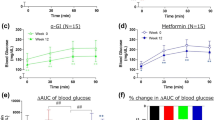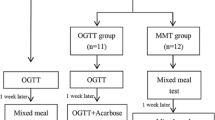Summary
The dose-dependency of the effects of the α-glucosidase inhibitor Miglitol (BAY m 1099) was investigated in 8 Type II diabetic patients.
Administration of increasing doses of Miglitol once daily in the morning on four consecutive days concomitantly with a standardized meal containing 50 g starch led to a dose-dependent reduction in the maximal increase in the postprandial blood glucose level and in postprandial incremental AUC of blood glucose. The latter was significant for 50, 100, 75 and 200 mg Miglitol. Bay m 1099 also markedly retarded the appearance of the peak postprandial blood glucose concentration, which indicates delayed carbohydrate absorption.
Serum insulin levels, documented as incremental AUCs of the serum insulin excursions, were not reduced dose dependently, because of the impaired insulin secretory capacity of the patients.
Similar content being viewed by others
References
Puls W, Keup H, Krause HP, Thomas P, Hoffmeister F (1982) The concept of glucosidase inhibition and its pharmacological realization. First International Symposium on Acarbose, Montreux, October 1981, Creutzfeldt, W (ed). Excerpta Medica, Amsterdam, pp 16–26
Eichler HG, Korn A, Gasic S, Pirson W, Businger J (1984) The effect of a new specific α-amylase inhibitor on postprandial glucose and insulin excursions in normal subjects and Type II (non-insulin-dependent) diabetic patients. Diabetologia 26: 278–281
Taylor RH, Barka HM, Bowey EA, Canfields JE (1986) Regulation of the absorption of dietary carbohydrate in man by two new glucosidase inhibitors. Gut 27: 1471–1478
Arends J, Willms BH (1986) Smoothening effect of a new α-glucosidase inhibitor Bay m 1099 on blood glucose profiles of sulfonylurea treated type II diabetic patients. Horm Metab Res 18: 761–764
Hillebrand I, Boeme K, Gräfe KH, Wehling K, Fink H (1984) Effect of two new α-glucosidase inhibitors (Bay 1099 and Bay 1248) on postprandial blood glucose and serum insulin levels in normal subjects. Diabetologia 27: 288 (abstract)
Cauderay M, Tappy L, Temler E, Jequier E, Hillebrand I, Felber JP (1986) Effect of α-glycohydrolase inhibitors (Bay 1099 and Bay 1248) on sucrose metabolism in normal men. Metabolism 35: 472–477
Sachse G, Willms B (1979) Effect of the α-glucosidase inhibitor Bay g 5421 on blood glucose control of sulfonylurea and insulin treated diabetics. Diabetologia 17: 287–290
Lembcke B, Fölsch UR, Creutzfeldt W (1985) Effect of 1-desoxynojirimycin derivatives on small intestinal disacharidase activities and on active transport in vitro. Digestion 31: 120–127
Schmidt FH (1971) Methode der Harn- und blutzuckerbestimmung. In: Pfeiffer EF (ed) Handbook of diabetes mellitus, vol 2. Leemanns JF, München, pp 913–914
Waldhäusl W, Bratusch Marrain P, Dudzak R, Deutsch E (1977) The diabetogenic action of somatostatin in healthy subjects and maturity onset diabetics. J Clin Endocrinol Metab 44: 876–833
Mann JI (1980) Diet and diabetes. Diabetologia 18: 89–95
American Diabetes Association (1986) Nutritional recommendations and principles for individuals with diabetes mellitus. Diabetes Care 10: 126–132
Töller M, Klischan A, Schleppinghoff B, Hillebrand I (1987) Einfluß der Kohlenhydratzufuhr auf die Stoffwechselwirkung von Miglitol. Akt Endokrinol Stoffw 8: 218 (abstract)
Joubert PH, Foukaridis GN, Bopape ML (1987) Miglitol may have a blood glucose lowering effect unrelated to inhibition of α-glucosidases. Eur J Clin Pharmacol 31: 723–724
Willms B, Ahrens K, Lübke D, Arends J (1987) Resorptionsverzögerung der Kohlenhydrate beim Typ II Diabetes: Vergleich von Guar, Müsli und α-Glucosidaseinhibitoren (Bay 1099). Akt Endokrinol Stoffw 8: 120 (abstract)
Klischan A, Toeller M, Schleppinghoff B, Hillebrand I, Gries FA (1987) Miglitol bewirkt eine signifikante Senkung postprandialer Blutglukosewerte. 6 Monate Doppelblind-Crossover-Studie bei Sulfonylharnstoff-behandelten Typ-II-Diabetikern. Akt Endokrinol Stoffw 8: 90 (abstract)
Raptis S, Dimitriatis G, Karaiskos K, Rosenthal J, Zoupas Ch, Moulopoulos S (1980) Long-term effects of an α-glucosidase inhibitor on catecholamine levels and insulin requirements as assessed by the artificial β-cell. Diabetes 29 [Suppl 2]: 163 (abstract)
Dimitriatis G, Karakaiskos K, Raptis S (1986) Effects of prolonged (6 months) α-glucosidase inhibition on blood glucose control and insulin requirements in patients with insulin dependent diabetes mellitus. Horm Metab Res 18: 253–255
Vierhapper H, Bratusch-Marrein, Waldhäusl W (1978) α-glucoside hydrolase inhibition in diabetes. Lancet 1: 1386
Author information
Authors and Affiliations
Rights and permissions
About this article
Cite this article
Heinz, G., Komjati, M., Korn, A. et al. Reduction of postprandial blood glucose by theα-glucosidase inhibitor Miglitol (BAY m 1099) in Type II diabetes. Eur J Clin Pharmacol 37, 33–36 (1989). https://doi.org/10.1007/BF00609420
Received:
Accepted:
Issue Date:
DOI: https://doi.org/10.1007/BF00609420




